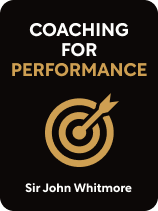

This article is an excerpt from the Shortform book guide to "Coaching for Performance" by Sir John Whitmore. Shortform has the world's best summaries and analyses of books you should be reading.
Like this article? Sign up for a free trial here.
Want to learn how to build a coaching session structure? What are the basic steps for creating a coaching session?
In Coaching for Performance, Sir John Whitmore explains how to effectively coach for performance, starting with how to structure coaching sessions so you can make the most of your time with your coachee. He claims there are four essential steps in building an effective session.
Read on to learn how to build a coaching session structure in four steps, according to Whitmore.
Create a Coaching Session Structure
In Coaching for Performance, Sir John Whitmore provides strategies to maximize employees’ potential and performance, starting with building an effective coaching session structure. In this article, we’ll look at the four steps for structuring a coaching session, which Whitmore outlines in Coaching for Performance.
Whitmore’s Four Steps
Whitmore says that whether you work within an organization or have been contracted to provide performance coaching services, you can maximize your coaching sessions’ effectiveness by putting a clear structure in place before you begin. This structure should include:
1. The time frame over which coaching will take place. Whitmore recommends a six-month duration, which gives your coachee time to practice building new habits and develop a good working relationship with you.
(Shortform note: A study examining the frequency of coaching conversations found that coachees who had more frequent sessions (every one-to-two weeks) experienced more positive results than those who had them every two-to-three or three-to-four weeks.)
2. The preferred format and number of hours per session. This will vary depending on whether your coachee’s company wants you to conduct sessions in person, virtually, or using a combination of the two. Whitmore says a typical coaching structure allows for 60 minutes per session.
(Shortform note: One study of coaching practices found that 30-39 minute sessions are more popular than 60-69 minute sessions. Further, coachees’ awareness can deteriorate over the course of longer sessions.)
3. A consultation meeting with your prospective coachee. The purpose of this meeting is to ensure that you and your coachee are a good match for work together.
(Shortform note: Experts also suggest that before the meeting, you gather intel on your prospective client to better understand and establish common ground with them. For example, look at their social media to see their personal interests. Then, at your meeting, mention that you, too, love monster trucks.)
4. A follow-up meeting to set expectations. Another important step in Whitmore’s coaching session structure is considering what the future holds for you and your coachee. Once you’ve agreed to work together, meet with your coachee to discuss logistics, the nature of your work, and your respective wants. To make the most of this conversation:
- Enter with a positive mindset. Before the meeting, gather your thoughts by asking yourself: “If this conversation went better than I could ever dream of, what would that look like?” Then, let go of negative thoughts about yourself, the meeting, and the other person so you can focus on your, your coachee’s, and the situation’s greatest potential.
- (Shortform note: A different way to foster positivity is to practice mindfulness to reduce stress and boost your mood. To do this, acknowledge and accept difficult thoughts and emotions with kindness and non-judgment. This creates space to focus on the positive.)
- Establish expectations of your work. Clarify that coaching is a partnership in which both parties must participate equally and that it’s a practice intended to help your coachee maximize their potential, not a mentoring or counseling relationship.
- (Shortform note: Experts offer more detail than Whitmore on what makes mentors and counselors different from coaches. Mentors typically engage with mentees in a long-term, unpaid relationship to provide career and emotional support and build networks. Counselors are paid to create safe, supportive spaces to help clients cope with challenges, solve problems, and identify what they want in life.)
- Be curious. Demonstrate genuine interest in your coachee to build trust and encourage them to share information and ideas with you. To do this, ask about their expectations and needs. For example: “What does an ideal working relationship between us look like to you?” “What support do you need?” “What should we do when we hit roadblocks?”
- (Shortform note: Even as you show interest in your coachee to build trust, they may not want to work with or open up to you. In this case, don’t judge—just consider reasons this may be true. For instance, maybe their employer mandated coaching or they don’t want to answer questions that feel personal. If their resistance is too great to reasonably make progress and their performance issues aren’t urgent, put the coaching on hold. If the issues require immediate attention, bring in HR or an outside consultant to help.)
- Seek permission. When you ask permission to share observations, you cultivate trust and help your coachee buy in to the coaching process. Try asking, “May I offer a thought about what you just said?” or “Can I suggest an idea?”
- (Shortform note: Paradoxically, while coaches stress the importance of permission in their coaching relationships, some advise female coachees not to ask permission at work to avoid missing out on career opportunities. Successful people don’t ask for permission to do things in life—they act based on their gut and convictions and are more innovative in their work as a result.)

———End of Preview———
Like what you just read? Read the rest of the world's best book summary and analysis of Sir John Whitmore's "Coaching for Performance" at Shortform.
Here's what you'll find in our full Coaching for Performance summary:
- A guide on the ins and outs of performance coaching
- Strategies to maximize employees’ potential and performance
- How to measure organizational culture and the impact of your work






